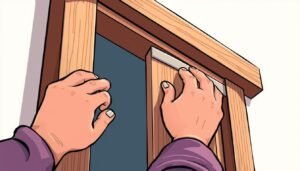Your home’s protection system works silently but needs regular attention. Those channels along your eaves play a vital role in safeguarding your property.
They direct rainfall away from your structure, preventing costly harm to your walls and base. When these pathways get blocked, you risk serious problems.
This guide offers a professional approach to maintaining these essential components. We will cover everything from routine checks to long-term strategies.
Proper care ensures your residence remains safe and retains its value. Let’s explore how to protect your investment effectively.
Key Takeaways
- Clean gutters are essential for protecting your home from water damage
- Proper maintenance prevents roof leaks and foundation issues
- Gutter cleaning should be performed seasonally throughout the year
- Professional maintenance approaches extend the life of your gutter system
- Neglected gutters can lead to costly home repairs and decreased property value
- Regular cleaning maintains optimal water drainage during heavy rainfall
- Implementing long-term strategies reduces maintenance frequency and costs
The Critical Role of Gutters in Protecting Your Home
Your property’s defense mechanism starts overhead with a crucial component. This system manages precipitation runoff from your overhead structure.
It serves as the primary barrier against moisture-related problems. Without proper function, your residence faces multiple risks.
These channels collect precipitation and direct it away from vital areas. They safeguard your base from excessive moisture accumulation.
This prevents foundation cracking and settlement issues over time. Proper drainage maintains structural stability throughout your property.
During heavy storms, these components handle increased volume efficiently. They prevent basement flooding by controlling runoff direction.
Your exterior walls and finishes remain protected from splashback and staining. This preservation extends the life of your siding materials.
Landscaping benefits significantly from controlled water management. Plants and soil avoid erosion from uncontrolled runoff.
The entire perimeter stays intact without washouts or soil loss. Your investment in exterior aesthetics remains protected.
Consistent performance requires professional understanding of hydraulic principles. Optimal operation depends on correct slope and capacity calculations.
Homeowners benefit from recognizing this system’s comprehensive protection role. It represents an essential investment in property preservation.
Consequences of Neglecting Your Gutter System
Property owners often underestimate the domino effect of neglected water management systems. What begins as simple blockage escalates into serious property concerns.
Overflowing channels cause foundation deterioration through constant moisture exposure. This leads to settlement cracks and compromising structural integrity.
Wooden components experience accelerated decay when exposed to persistent dampness. Fascia boards and trim materials weaken, requiring costly replacements.
Interior spaces suffer from moisture penetration during heavy storms. Attics develop dampness that compromises insulation effectiveness.
Debris accumulation creates ideal habitats for unwanted visitors. Birds, rodents, and insects establish colonies in clogged passages.
Mold development becomes inevitable with constant moisture presence. These growths affect air quality and surface materials throughout your home.
Cold climates present unique winter challenges with ice formation. Frozen blockages create barriers that prevent proper drainage.
Soil stability around your property diminishes with uncontrolled runoff. Landscaping suffers erosion while pathways become unstable.
Visible stains from overflowing systems diminish curb appeal significantly. Dark streaks on exterior surfaces indicate chronic overflow issues.
Health concerns arise from mold spores affecting indoor air quality. Allergy sufferers experience symptoms from poor environmental conditions.
Financial impacts become substantial when addressing preventable damage. Major repairs often cost significantly more than routine maintenance.
Professional assessment helps homeowners understand these interconnected risks. Early intervention prevents the cascade of deterioration.
Establishing an Effective Seasonal Cleaning Schedule
Strategic timing represents the cornerstone of preserving your home’s exterior water management system. Proper scheduling prevents debris accumulation that compromises performance.
Most residential properties benefit from biannual attention to their drainage channels. This approach addresses nature’s cyclical patterns effectively.
Spring attention removes winter’s accumulated organic matter. This preparation ensures optimal function during rainy periods.
Autumn preparation proves equally critical before cold months arrive. Clearing channels before precipitation peaks prevents ice blockages.
Late spring represents the ideal window after tree shedding concludes. Early autumn work precedes heavy rainfall seasons.
Properties in storm-prone regions require additional attention throughout the year. Post-weather event checks maintain continuous protection.
Tree density significantly influences maintenance frequency requirements. Heavy foliage areas may need quarterly attention.
Regional climate patterns dictate specific scheduling considerations. Arid regions differ from humid coastal areas.
Professional evaluation should accompany each scheduled maintenance session. Visual assessment identifies potential issues early.
Weather monitoring helps optimize your maintenance calendar timing. Adjust schedules based on local forecast patterns.
Documenting each service creates valuable historical data for future planning. Track patterns to anticipate optimal service times.
A Step-by-Step Guide to Cleaning Your Gutters
Effective drainage system care involves three distinct phases of attention. This systematic approach ensures thorough maintenance while prioritizing safety throughout the process.
Step 1: Safely Inspect for Damage and Debris
Begin with a comprehensive evaluation of your entire drainage network. Use a sturdy ladder placed on level ground with proper stabilization.
Wear non-slip footwear and maintain three points of contact while ascending. Carefully examine each section for visible problems.
Look for separation at joints, metal fatigue, and improper alignment. Note areas where organic matter has accumulated significantly.
Document any concerns requiring professional attention during your assessment. This preliminary check prevents overlooking crucial repair needs.
Step 2: Remove Debris and Clear Downspouts
Wear protective gloves and use a specialized scoop for material extraction. Work systematically from the downspout outward for efficiency.
Place removed material in a bucket attached to your ladder for easy disposal. Pay particular attention to corners where blockages typically form.
For stubborn vertical pipe obstructions, employ a plumber’s auger tool. Insert carefully and rotate to break up compacted material.
This thorough removal process prepares the system for verification testing.
Step 3: Flush the System and Verify Proper Drainage
Use a garden hose to test performance after debris extraction. Begin at the end opposite your downspout and observe liquid movement.
Check that discharge points direct moisture away from your foundation adequately. The optimal distance measures four to six feet from your structure.
Observe the entire pathway for leaks or overflow during this verification. Note any sections requiring adjustment or professional services.
This final confirmation ensures your maintenance efforts achieve intended results. Proper function protects your property investment effectively.
Long-Term Strategies for Reduced Gutter Maintenance
Investing in quality gutter guards offers lasting protection for your home. Micro-mesh systems effectively block debris while allowing proper drainage.
Professional installation ensures optimal performance across different climates. This approach significantly reduces how often you need maintenance.
Even with protection, periodic inspection remains essential after major storms. Trusted services provide expert installation and care.
This investment preserves your property’s value while minimizing upkeep. Choose solutions that match your regional weather patterns.



